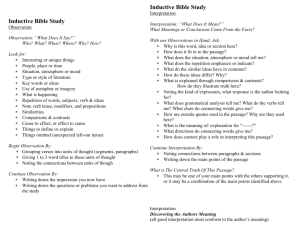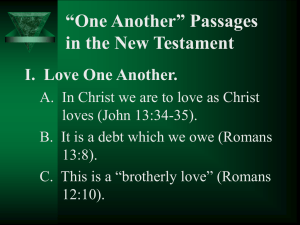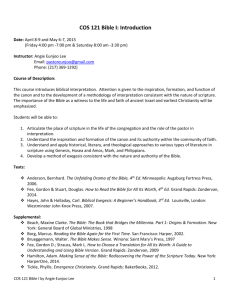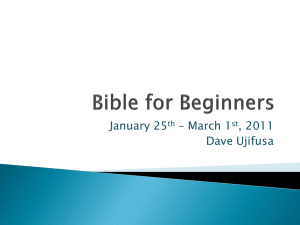Hermeneutic Systems and the Grammatical
advertisement
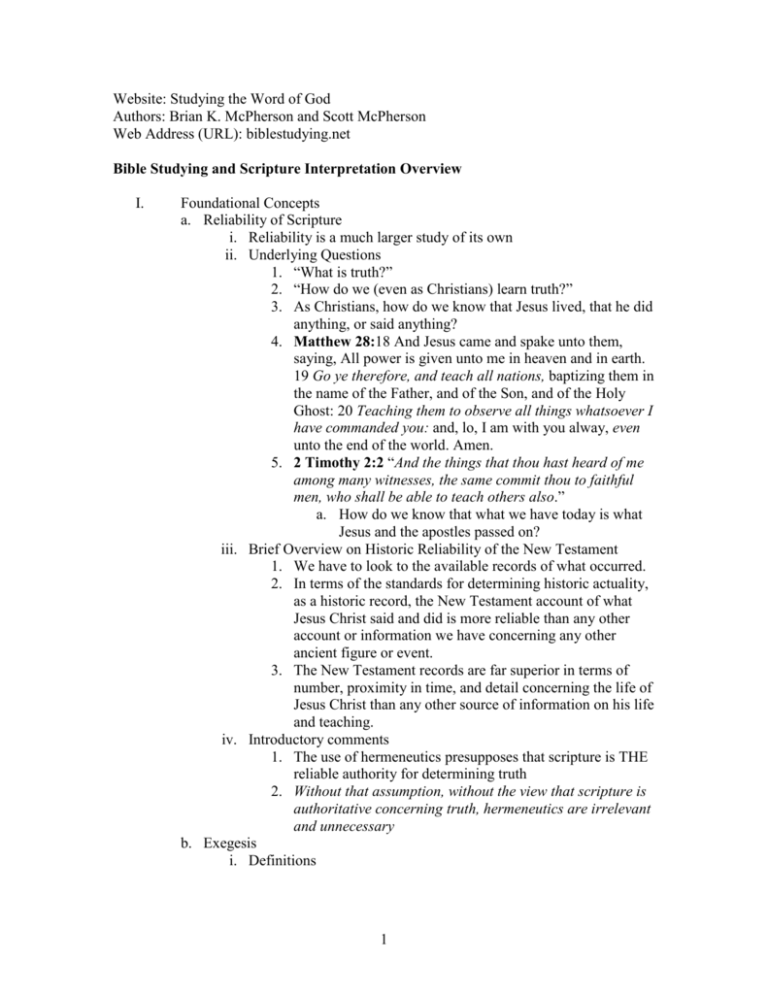
Website: Studying the Word of God Authors: Brian K. McPherson and Scott McPherson Web Address (URL): biblestudying.net Bible Studying and Scripture Interpretation Overview I. Foundational Concepts a. Reliability of Scripture i. Reliability is a much larger study of its own ii. Underlying Questions 1. “What is truth?” 2. “How do we (even as Christians) learn truth?” 3. As Christians, how do we know that Jesus lived, that he did anything, or said anything? 4. Matthew 28:18 And Jesus came and spake unto them, saying, All power is given unto me in heaven and in earth. 19 Go ye therefore, and teach all nations, baptizing them in the name of the Father, and of the Son, and of the Holy Ghost: 20 Teaching them to observe all things whatsoever I have commanded you: and, lo, I am with you alway, even unto the end of the world. Amen. 5. 2 Timothy 2:2 “And the things that thou hast heard of me among many witnesses, the same commit thou to faithful men, who shall be able to teach others also.” a. How do we know that what we have today is what Jesus and the apostles passed on? iii. Brief Overview on Historic Reliability of the New Testament 1. We have to look to the available records of what occurred. 2. In terms of the standards for determining historic actuality, as a historic record, the New Testament account of what Jesus Christ said and did is more reliable than any other account or information we have concerning any other ancient figure or event. 3. The New Testament records are far superior in terms of number, proximity in time, and detail concerning the life of Jesus Christ than any other source of information on his life and teaching. iv. Introductory comments 1. The use of hermeneutics presupposes that scripture is THE reliable authority for determining truth 2. Without that assumption, without the view that scripture is authoritative concerning truth, hermeneutics are irrelevant and unnecessary b. Exegesis i. Definitions 1 1. “Exegesis – the critical interpretation of the biblical text to discover its intended meaning. Both Jews and Christians have used various exegetical methods throughout their history, and doctrinal and polemical intentions have often influenced interpretive results; a given text may yield a number of very different interpretations according to the exegetical presuppositions and techniques applied to it. The study of these methodological principles themselves constitutes the field of hermeneutics (q.v.).” – Britannica.com 2. "Exegesis - [N.L. - Gr. exegesis, - exegeisthai, explain, ex-, out of, and hegeisthai, lead.] Critical explanation or interpretation, esp. of Scripture." - The Living Webster Encyclopedic Dictionary of the English Language a. With regard to meaning, “to lead out of” the text itself rather than “from outside” into the text 3. “Eisegesis – the interpretation of a text (as of the Bible) by reading into it one's own ideas -- compare EXEGESIS, Etymology: Greek eis into (akin to Greek en in) + English exegesis.” – Merriam-Webster Online Dictionary 4. “Hermeneutics – NOUN: (used with a sing. or pl. verb) The theory and methodology of interpretation, especially of scriptural text.” – The American Heritage® Dictionary of the English Language: Fourth Edition. 2000. ii. Purpose 1. to let scripture reveal its own meaning 2. without exegesis governed by sound hermeneutic principles, scripture becomes merely vessel into which we pour our own meaning, ideas, or imaginations a. i.e., we become the authority and NOT the scripture c. Variety of Hermeneutic Systems i. (http://www.xenos.org/essays/hermsys.htm) ii. The Allegorical Method 1. Definition - The literal meaning of the text is either, not the true meaning, or only one of many meanings. The elements of each passage have a corresponding spiritual reality which is the "real" or ultimate meaning of the passage. iii. The Naturalistic Method 1. Definition - The naturalistic world-view (i.e. the universe is a closed system of cause and effect) is the standard by which scripture must be interpreted. Scripture becomes intelligible only as ancient man's attempt to explain nature. It also assumes that religion has evolved through several stages which can be used to date the material in the Bible. a. Miracles are rejected as primitive explanations or myths. 2 b. The goal is to rediscover the "true record" (i.e., the "historical" Jesus, or the "strata" in the Pentateuch) within the legendary accounts of the Bible. iv. Neo-Orthodox Interpretation 1. Definition - Neo-orthodoxy takes an approach to theology that places the religious experience of the interpreter in the center. The Bible is important for stimulating such an experience. When it does so, it "becomes the word of God" for that reader, at that time. Neo- orthodox theologians are generally willing to accept the conclusions of the naturalistic theologians regarding errors in the Bible, but feel that these do not affect the reader's ability to encounter God through it. v. Devotional Interpretation 1. Definition - The devotional method focuses almost exclusively on what is personally applicable and edifying. It tends to ignore context, historical background, and other important interpretive principles. d. History – Traces of the Grammatical-Historical Method i. General Comments 1. the basic concepts are not novel or modern 2. trace back to earliest history 3. articulated in various ways at various times in Christian history ii. New Testament and Early Church 1. The exegetical practices of the apostles and New Testament authors forms the basis of the grammatical-historical method 2. Later articulations of the grammatical-historical method to one extent or another were based upon the New Testament model a. “Biblical literature, Early Stages – The New Testament writers shared a creative and flexible principle of exegesis that has regard for the literary and historical context and traces a consistent pattern of divine action in judgment and mercy, reproduced repeatedly in the history of Israel and manifested definitively in Christ.” – Britannica.com b. “The apostles followed their Lord in regarding the Old Testament as the inspired Word of God (2 Tim. 3:16; 2 Peter 1:21). In at least fifty-six instances God is explicitly referred to as the author of the biblical text. Like Christ, they accepted the historical accuracy of the Old Testament (e.g., Acts 7:9-50; 13:16-22; Heb. 11).” – Hermeneutics: 3 Principles and Process of Biblical Interpretation, by Henry A. Virkler, p. 55 c. “In conclusion, the vast majority of the New Testament references to the Old Testament interpret it literally; that is, they interpret according to the commonly accepted norms for interpreting all types of communication—history as history, poetry as poetry, and symbols as symbols. There is not attempt to separate the message into literal and allegorical levels… Thus, the New Testament itself lays the basis for the grammatical-historical method of modern evangelical hermeneutics.” – Hermeneutics: Principles and Process of Biblical Interpretation, by Henry A. Virkler, p. 58 iii. Summaries 1. “Biblical literature, The Patristic Period – Alexandria had long boasted a school of classical study that practiced the allegorical interpretation of the Homeric epics and the Greek myths...Later, the Antiochene fathers, represented especially by Theodore of Mopsuestia (c. 350– 428/429) and John Chrysostom (c. 347–407), patriarch of Constantinople, developed an exegesis that took more account of literal meaning and historical context...In the West, the Alexandrian methods were adopted by Ambrose (c. 339–397), bishop of Milan, and Augustine (354–430), bishop of Hippo…” – Britannica.com 2. (also known as “Literal Interpretation”) “Hermeneutics, Literal Interpretation – Literal interpretation asserts that a biblical text is to be interpreted according to the “plain meaning” conveyed by its grammatical construction and historical context. The literal meaning is held to correspond to the intention of the authors…Jerome, an influential 4th-century biblical scholar, championed the literal interpretation of the Bible in opposition to what he regarded as the excesses of allegorical interpretation. The primacy of the literal sense was later advocated by such diverse figures as Thomas Aquinas, Nicholas of Lyra, John Colet, Martin Luther, and John Calvin.” – Britannica.com iv. Augustine 354-430 1. Include: a. The literal and historical meaning of Scripture should be held in high regard. b. The task of the expositor is to understand the meaning of the author, not to bring his own meaning to the text. 4 c. A verse should be studied in its context, not in isolation from the verses around it. d. The Holy Spirit is not a substitute for the necessary learning to understand Scripture. The interpreter should know Hebrew, Greek, geography, and other subjects. e. The obscure passage must yield to the clear passage. f. The expositor should take into account that revelation is progressive. 2. Quoted from Hermeneutics: Principles and Process of Biblical Interpretation, by Henry A. Virkler, p. 60-61, in which the author himself cites Ramm, Protestant Biblical Interpretation, pp. 36-37. v. Martin Luther, 1483-1546 1. a few quotes a. "…nothing is more commonly stated or more generally accepted than the idea that the Scriptures are obscure and ambiguous, so that the spirit to interpret them must be sought from the Apostolic See of Rome. Nothing more pernicious could be said than this, for it has led ungodly men to set themselves above the Scriptures and to fabricate whatever they pleased, until the Scriptures have been completely trampled down and we have been believing and teaching nothing but the dreams of madmen." – Luther, Bondage 158-159. b. “The literal sense alone is the whole essence of faith and Christian theology.” – A. Skevington Wood,. Luther’s Principles of Biblical Interpretation. (London: Tyndale Press, 1960), 7. 2. Luther’s German translation of the Bible in 1521 and 1528 included hermeneutic principles: a. on the necessity for grammatical knowledge; b. on the importance of taking into consideration the times, circumstances and conditions; c. on the observance of the context; d. on the need of faith and spiritual illumination; e. on keeping what he called the "proportion of faith" for maintaining the perspicuity of Scripture (often called the analogy of faith principle); f. on the reference of all Scripture to Christ. (Farrar, History of Interpretation, 232.) 3. Its been argued that Luther’s principles were influenced by Erasmus vi. Erasmus 1469-1536 5 1. He was ordained priest of the Roman Catholic Church 2. “Erasmus helped lay the groundwork for the historicalcritical study of the past, especially in his studies of the Greek New Testament and the Church Fathers.” – Britannica.com 3. the interpreter… a. should weigh not only what is said but also by whom it is said. b. should observe to whom the words were said. c. should see what words were used at what time and on what occasion. d. should note what precedes and what follows the words under consideration, that is, the historical and literary context must be known. e. should have a knowledge of Hebrew, Greek and Latin as well as the disciplines of dialectic, arithmetic, music, natural science, history and especially grammar and rhetoric (both of which were preferred to dialectic).[19] f. should handle the ambiguities and apparent contradictions by textual emendation and knowledge of grammar. If difficulties still remain, then obscure passages should be correlated with other passages to bring illumination to the problematic texts, which often led to allegorical interpretations. Also, these difficult passages should be viewed from within the circle of orthodox Christian doctrine, the teachings of Christ and common sense (= law of nature; for Erasmus, the law of Christ and the law of nature were in essential agreement).[20] g. should at this point look to the Fathers[21] (the Greek Fathers are preferred to the Latin Fathers) and the classical writers for additional insight for the literal and spiritual meaning of the text.[22] 4. http://www.omegapage.com/Foundations/Translating/eras mus.htm a. [22] These principles are summarized and expanded in J. B. Payne, "Toward the Hermeneutics of Erasmus" in Melanges, Scrinium Erasmianum, vol. 2, edited by J. Coppens, cited in Payne, Erasmus: His Theology, 45, 46, 252. vii. Commentaries on these men will sometimes also make note that in practice they did not always live up to their own hermeneutic principles 6 II. The Grammatical-Historical Method a. Basic Concept i. Sometimes known as “Literal Interpretation” ii. “Hermeneutics, Literal Interpretation – Literal interpretation asserts that a biblical text is to be interpreted according to the “plain meaning” conveyed by its grammatical construction and historical context. The literal meaning is held to correspond to the intention of the authors.” – Britannica.com b. Main Rules i. Meaning is determined/bound by Grammar 1. Basics a. The plain or normal meaning of the text is the authoritative meaning. b. Allegorical interpretation is generally limited to only those passages where allegory was the clear and expressed intent of the speaker or author. 2. Determining Factors a. Verb – tense, mood, voice b. Nouns – pronouns, singularity, plurality, first person, second person, third person c. Word meaning i. (more later under Studying Techniques) d. Figures of speech, such as metaphors, similes, etc. are taken as such, including symbolic visions, etc. ii. Meaning is determined/bound by Historical Context 1. Basics a. Builds on the grammatical consideration i. we want to understand phrases and concepts the way that 1. the original author used them 2. and the original audience would have understood them 3. those 2 are inherently connected b. The way that the text was understood in its original, historical context by its author and by the original audience is the authoritative meaning. i. The Bible was written to common people, and is understandable to anyone. ii. However, it was written thousands of years ago to a different culture. iii. Therefore, as modern readers, we have to try to recover a general sense of the meaning of words, phrases and concepts in the ancient cultures. 7 c. We are NOT interested at first in the question, "What does it mean to me?" but instead, "what did it mean to those whom it was originally written?" 2. Determining Factors a. When in God’s plan/under which covenant was the passage written or the statement made? b. consider the author/speaker i. what prior revelation had they received? ii. what was his intent? iii. What was his personal circumstances? c. consider the original audience i. what prior revelation had they received? ii. What were their personal circumstances? d. For insight into early interpretations of a passage, compare to Apostolic Christian authors of the first and second century i. this is only helpful and in no way binding e. Use Bible dictionaries or other sources to discover customs, money, geography, timeframe, etc. iii. Meaning is determined/bound by Progressive Revelation 1. Basics a. Builds on the historical consideration b. God has revealed truth to man over time c. The scripture is a record of what God had revealed at what time d. Later revelations build upon previous revelations e. What a person already understands about a topic informs and shapes new information that they receive on that topic i. when determining how an original audience would have interpreted a statement or teaching we cannot factor into their understanding information that they did not yet at that time possess ii. however, when compiling a start to finish composite the information in all passages (early and later) should be combined into a uniform whole f. Therefore, the interpretation of each passage must be limited in terms of i. what was already revealed and therefore already shaping the author and audience’s understand ii. what was not already revealed and therefore outside of the author or audience’s understanding 8 g. Under which covenant was the statement made or passage written? h. Primary application of the passage will be to the people operating under that program, but not necessarily to everyone of all ages and under all covenants. 2. “Law of First Reference” a. theory that the first time a concept is mentioned in scripture, it is defined for us in that passage b. this serves as the precedent/definition of that term from that point forward (when it is used as a technical term or phrase) i. some vocabulary words are used to refer to more than one item iv. Meaning is determined/bound by the Rules of Logical Analysis 1. *Objectivity a. if subjective considerations will dictate our interpretation we might as well abandon a scripture altogether 2. Law of Non-Contradiction a. Your interpretation must make rational sense. b. If interpretation is permitted to contradict, there is no reason for hermeneutics since we may make a passage say whatever we want regardless of what is said elsewhere. v. Meaning is determined/bound by Context 1. is determined/bound by the rules of logical analysis 2. let scripture interpret scripture 3. Moving from inside outward a. Surrounding verses, chapter, book, testament, entire Bible i. particularly passages on the same or similar topic ii. particularly passages by the same author b. keeping in mind progressive nature and order of divine revelation vi. Meaning is determined/bound by Harmony and Unity 1. Builds upon the Law of Non-contradiction and Progressive Revelation 2. Scripture is not a connection of isolated and unrelated sentences or comments a. Because of the progressive nature of divine revelation, connection to prior revelation must be considered b. God is building a uniform whole 9 c. While we cannot connect two passages or teachings without warrant, likewise we do not want to isolate every statement from previous statements, particularly those on the same topic 3. We want to reconcile statements in scripture a. Statements on the same topic b. Statements on different topics i. views in one area should not contradict views in another area ii. This is known as Systematic Theology vii. Meaning is determined/bound by Priority of Clarity 1. interpret unclear or difficult passages in light of clear, plain statements a. never build a doctrine on an unclear passage b. never let a less clear statement overrule the meaning of a clearer one c. Special Types of Passages i. Prophecy 1. Particularly prophetic passages that scripture itself does NOT record as having been fulfilled by the close of the New Testament canon 2. Standard prophetic passages, including: a. prophetic statements not employing symbolic imagery – simply describing in normal language what will happen i. plain statements, including chronology, times, events, etc. should be taken plainly, unless otherwise specifically stated in the text b. Dreams and visions with symbols 3. Concerning symbols, dreams, and visions a. meaning vs. identification i. the symbol’s meaning is what concept the symbol represents 1. example, horn = king ii. the symbol’s identification is what actual historic person or entity the symbol represents 1. example, head of gold = Nebuchadnezzer b. If a passage gives the meaning or identification, we are bound by the meaning or identification given in the text c. If the passage does not give the meaning or identification, then any meaning or identification deduced from the text is speculative and not binding 10 i. interpretations should always be based upon what is stated somewhere in scripture d. One Single, Identifiable Exception 1. “The Mystery” of Christ a. Colossians 4:3 “Withal praying also for us, that God would open unto us a door of utterance, to speak the mystery of Christ, for which I am also in bonds…” b. Quote from earlier i. “…interpret according to the commonly accepted norms for interpreting all types of communication—history as history, poetry as poetry, and symbols as symbols.” – Hermeneutics: Principles and Process of Biblical Interpretation, by Henry A. Virkler, p. 58 c. What is “The Mystery” of Christ? i. Many prophecies concerning the first advent of Jesus Christ were veiled in such a way that they fall OUTSIDE “the commonly accepted norms for…all types of communication” 1. that is what Paul meant by the phrase, “the Mystery” Luke 24:44 And he said unto them, These are the words which I spake unto you, while I was yet with you, that all things must be fulfilled, which were written in the law of Moses, and in the prophets, and in the psalms, concerning me. 45 Then opened he their understanding, that they might understand the scriptures, 46 And said unto them, Thus it is written, and thus it behoved Christ to suffer, and to rise from the dead the third day: 47 And that repentance and remission of sins should be preached in his name among all nations, beginning at Jerusalem. Romans 16:25 Now to him that is of power to stablish you according to my gospel, and the preaching of Jesus Christ, according to the revelation of the mystery, which was kept secret since the world began, 26 But now is made manifest, and by the scriptures of the prophets, according to the commandment of the everlasting God, made known to all nations for the obedience of faith: ii. Thus, these prophecies fall OUTSIDE the grammatical-historical rules of interpretation iii. Examples First Example: 11 Psalm 16:8 I have set the LORD always before me: because he is at my right hand, I shall not be moved. 9 Therefore my heart is glad, and my glory rejoiceth: my flesh also shall rest in hope. 10 For thou wilt not leave my soul in hell; neither wilt thou suffer thine Holy One to see corruption. Acts 2:22 Ye men of Israel, hear these words; Jesus of Nazareth, a man approved of God among you by miracles and wonders and signs, which God did by him in the midst of you, as ye yourselves also know: 23 Him, being delivered by the determinate counsel and foreknowledge of God, ye have taken, and by wicked hands have crucified and slain: 24 Whom God hath raised up, having loosed the pains of death: because it was not possible that he should be holden of it. 25 For David speaketh concerning him, I foresaw the Lord always before my face, for he is on my right hand, that I should not be moved: 26 Therefore did my heart rejoice, and my tongue was glad; moreover also my flesh shall rest in hope: 27 Because thou wilt not leave my soul in hell, neither wilt thou suffer thine Holy One to see corruption. 28 Thou hast made known to me the ways of life; thou shalt make me full of joy with thy countenance. 29 Men and brethren, let me freely speak unto you of the patriarch David, that he is both dead and buried, and his sepulchre is with us unto this day. 30 Therefore being a prophet, and knowing that God had sworn with an oath to him, that of the fruit of his loins, according to the flesh, he would raise up Christ to sit on his throne; 31 He seeing this before spake of the resurrection of Christ, that his soul was not left in hell, neither his flesh did see corruption. 32 This Jesus hath God raised up, whereof we all are witnesses. Second Example: Psalm 22:15 My strength is dried up like a potsherd; and my tongue cleaveth to my jaws; and thou hast brought me into the dust of death. 16 For dogs have compassed me: the assembly of the wicked have inclosed me: they pierced my hands and my feet. 17 I may tell all my bones: they look and stare upon me. 18 They part my garments among them, and cast lots upon my vesture. Matthew 27:35 And they crucified him, and parted his garments, casting lots: that it might be fulfilled which was spoken by the prophet, They parted my garments among them, and upon my vesture did they cast lots. d. What’s the reason for the enigma or “mystery” i. to confirm – Acts 17:11, Acts 18:28 ii. to disguise – 1 Corinthians 2:7-8 2. Clear Limitations a. Pertains ONLY to Old Testament texts b. Pertains only to the first advent of Christ, including i. his death, ii. resurrection, iii. inauguration of a New Covenant, 12 iv. and inclusion of the Gentiles in that Covenant III. Practical Techniques for Studying and Analyzing Scripture a. Try to identify the key issues and key questions before beginning. i. Keep them in mind and review them as you proceed through the study. b. Bible Software and a word-editing program is the best way i. at your finger tip ii. copy and past (instead of retyping) iii. save files iv. highlight portions v. rearrange for association vi. *search by Strong’s Concordance Numbers AND Verb Conjugation Numbers c. *Surveys i. Impossible to underestimate the value of survey work 1. this is where you collect the data that you study a. any conclusion or analysis is only as good as the survey 2. the goal is to get as much information as possible a. the goal is NOT to get only part of the relevant information on a topic b. specifically, the goal is to collect ALL OF THE PASSAGES on a particular topic or point i. that way our analysis will not be made with key information missing that could change the outcome of the analysis 3. this is where it gets time-consuming and painstaking a. still, its not as difficult as you might think b. especially once you get the hang of it ii. 2 Types of Surveying 1. survey for “word meaning” a. or even for the limitations for a particular verb conjugation i. allows you to see how authors used a particular tense ii. what the limits of that tense are as the author’s used them 2. survey for other passages on the same topic iii. Surveying for word meaning (or verb conjugation) 1. done with Strong’s Numbers 2. *allows you to see how authors used a particular word or term a. this is key 13 i. a central issue is how word meaning is determined by comparison of the words in a variety of texts/passages ii. one point to consider is that any interpretation that relies upon defining a word in quite a novel way that effectively isolates it from its other occurrences should be considered with skepticism iii. this is a larger topic but we have a website with an article on these issues available at: 1. http://www.geocities.com/biblestudy ing/translation2.html b. sometimes leads to identifying “technical terms” 3. also helps you to find other passages on the same topic 4. limited in that it cannot cross Testaments a. each Bible language has a separate Strong’s Number catalog iv. Surveying for other passages on the same topic 1. search by Strong’s Numbers 2. search by English words a. allows you to cross Testaments b. leads to investigating Strong’s Numbers i. different Hebrew and Greek words may be translated into the same English word ii. ultimately it’s the original language that matters, not whether or not the same word is used in an English translation v. A major goal is to find and catalog any synonymous phrases or terms 1. i.e. terms or phrases that are used interchangeably in a Testament to refer to the same thing 2. without this, sometimes key passages or statements on the same topic are entirely missed, leaving out key information d. Underlying Manuscript Issues i. Understand manuscript/translation issues that deal with the reliability and accuracy of currently available Bible translations 1. different translations are based upon different manuscripts and therefore can render different passages in critically different ways ii. Basics 1. two basic divisions are a. KJV NKJV use Textus Receptus (based upon Traditional Manuscripts) – KJV was originally called Authorize Version 14 b. ALL other translations (NIV, NASB) use CT (Critical Texts of various editions including originally Westcott and Hort iii. Strong’s Concordance is only coded to the King James Version iv. *this is not to say that any English translation is “perfect” or “inspired” b. Comparison of Findings to Christian History i. Need to know some basics about different doctrines ii. When did a doctrine first come into articulation outside the canon of scripture? 1. the axiom, “in GENERAL, new doctrine is false doctrine” 1. if it wasn’t handed down by the apostles then it is false doctrine v. for comparison, we find the early Church Writers (sometimes known as the Apostolic Writers) of the first and second centuries to be very helpful 1. because they generally employ grammatical-historical principles a. whereas, starting prominently with Origen, Ambrose, and Augustine, the church has been struggling with tendencies toward allegorical hermeneutics b. in more modern times the church has increasingly struggled with tendencies toward more subjective, devotional styles of studying 2. they have very close proximity to the apostles themselves being only one or two generations removed 3. nevertheless, we consider them to be non-canonical, uninspired, and fallible IV. Practical Study Resources a. Websites for FREE Online Concordance and Bible Surveying i. http://www.eliyah.com/lexicon.html 1. free online Strong’s Concordance search 2. search by Strong’s Number or English word 3. a variety of other free features ii. http://blueletterbible.org/ 1. search by verse, word, phrase 2. see original Greek, side by side with English 3. free audio, video, and text commentaries 4. compare various versions side by side 5. view dictionary entries for any verse 6. images and maps also available b. FREE Bible Software i. PC/Windows - http://www.onlinebible.net/ 1. click on “Downloads” link 15 2. then click on “Program Files” 3. then click on “Starter Pack” and follow installation directions ii. Macintosh - http://www.cbbc.net/olb/ 1. click on “Macintosh Version” link 2. click on each link in the middle column under the heading “Online Bible - Macintosh Program and Modules (English)” 3. follow instructions 16

